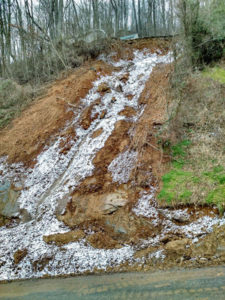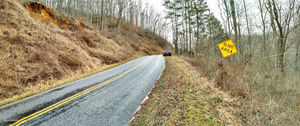This story was written by Tanner Hall, originally published in The Sylva Herald.

A debris flow on a modified slope along North Fork Road. Courtesy of Stephen Fuemmeler, Appalachian Landslide Consultants.
Geologists over the next few months will finish mapping all previous, current and potential landslides in Jackson County.
The information should be available by June, according to Jennifer Bauer of Appalachian Landslide Consultants, an Asheville-based firm. County officials hired the company for $143,000 in August 2015.
Bauer said that a typical slope failure brings about 20 dump-truck loads worth of sediment into the area’s natural-water supply. It usually costs between $50,000 and $100,000 to fix, she said.
“If we minimize the number of embankment failures that we have, we can save that much money and save that water-quality impact,” Bauer said. Additionally, “saving just one house pays for the cost of the mapping,” she said.
Bauer and her partner, Stephen Fuemmeler, updated county planning board members Feb. 9 on what they’ve found. They hope that compiling the information and creating maps helps property owners make smarter decisions about how to develop their land and prevent slides.
Geologists have mapped 305 landslides in Jackson County, 240 of which are field-verified. Bauer said Appalachian Landslide is creating a database that ranks landslide-prone areas. It’s based on how likely movement is in the future, what danger exists if the slope fails and how likely the sediment could reach a water source.
There are 66 mapped landslides with high or imminent movement potential, 29 landslides with potential to impact water quality and 19 landslides that pose a threat to public safety if they were to fail again, according to the information presented Feb. 9.
Bauer said there are four main types of landslides: debris flows and slides, rock falls, and weathered-rock slides, in which rock is broken down for years until it turns to soil.
Many of the landslides in Jackson County are debris flows that occur during or after heavy rain. In these, Bauer said, the soil is so saturated it can’t hold more moisture. It then flows down the slope, picking up rocks and trees, she said.
Geologists talked about North Fork Road off of Skyland Drive as an example.
“There is an abundance of landslides along North Fork Road,” Bauer said. “We believe much of that is due to when (transportation officials) widened the road, in conjunction with the rock type there.”
The road sits in the middle of a series of ancient landslide deposits, Bauer said, where landslides have come down over hundreds or thousands of years, leaving loose boulders and soil.
“What happens with these deposits is that because there are loose rocks and soil together, water can easily find pathways through,” she said. “When you are putting in steep cuts where there’s already a lot of water, and then we get big rain events, these deposits can become unstable.”
The N.C. Department of Transportation occasionally must scrape the road because soil comes downhill and bulges over the pavement, Bauer said.
In another example, this time near Cullowhee, Bauer said a property owner wanted to build a house on what turned out to be a large landslide deposit. Developers graded the land and installed footers. The next day, Bauer said, they came back and the footers were covered in soil, because of a slide.
The property owner decided that wasn’t the place to build a house, she said.

A weathered-rock slide on a modified slope along North Fork Road. The “slide area” sign is gradually moving downslope due to the unstable ground. Courtesy of Stephen Fuemmeler, Appalachian Landslide Consultants.
Seventy-six percent of the landslides mapped were on modified slopes, either through construction or grading, while 22 percent of the slides were on natural slopes. (Geologists aren’t sure about the other 2 percent; those slides have not yet been field-verified, Bauer said.)
Geologists will create susceptibility maps once the exploratory work is finished. These will show where slides are likely to start during heavy rain, where those slides might move downslope and construction-caution areas where developers need to be careful when working with the land.
Subsidence points will be marked. These are areas along roadside embankments that can be fixed but are showing signs of failure and could cause movement when the next hurricane-type rains come through. Officials or homeowners’ association groups, once aware of any potential failures, could choose to fix the area in the short-term, rather than paying the price down the line, Bauer said.
Other counties in Western North Carolina have gone through similar landslide-mapping efforts.
Macon, Buncombe Henderson and Watauga counties were done by the N.C. Geological Survey. Bauer and Fuemmeler were a part of that team, until state legislators decided to no longer fund that program. That’s when they started Appalachian Landslide Consultants and began mapping parts of Haywood and Jackson counties.
The firm currently distributes information for Haywood County online. Bauer said the plan is to have Jackson County’s maps available online as well, along with user guides to walk people through steps they can take if they live in a landslide-prone area.
Geologists will hold a workshop to teach people how to use the maps and learn from the data.
Planning board members asked how those purchasing property will know about the land they’re looking at. Bauer said that she and Fuemmeler are members of the Board of Realtors in Haywood and Buncombe counties.
“We try to educate as many Realtors as we can,” Bauer said. “They see the benefits of this information, because then they’re not liable,” she said.
Officials do not plan to use the maps for any regulatory functions, such as creating or changing an ordinance, county Planning Director Mike Poston said.



